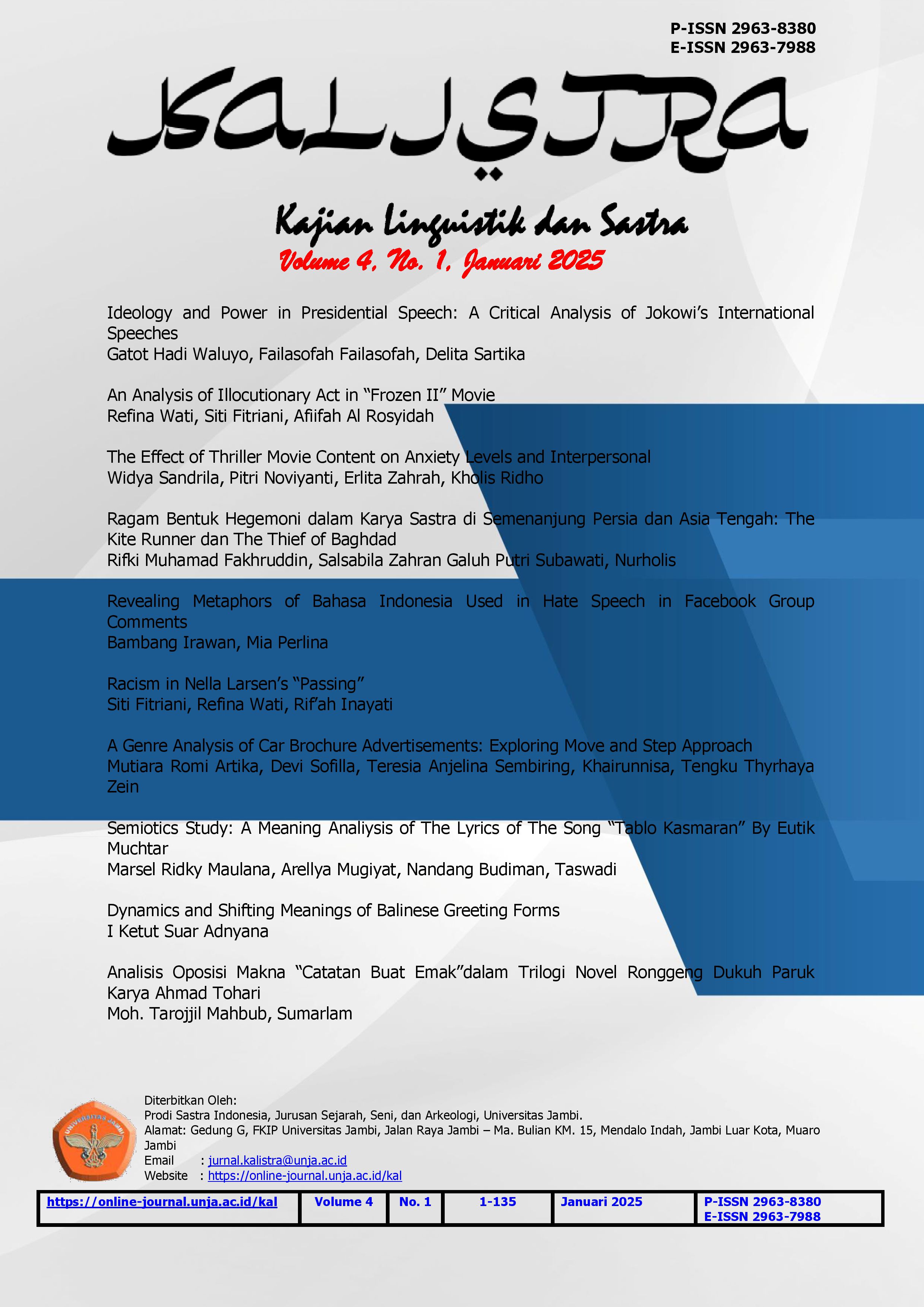Struktur Naratif Novel Kuda Karya Panji Sukma
DOI:
https://doi.org/10.22437/kalistra.v4i1.44613Keywords:
Narrative structure, literary work, novelAbstract
This research is motivated by the importance of understanding narrative structure in literary works as part of understanding the content of the story. The novel Kuda by Panji Sukma was chosen as a data source because it has a complex storyline and won the first award in the novel category at the 2024 Ministry of Education, Culture, Research, and Technology Literature Award. The purpose of this study was to determine the narrative sequence, narrative duration, and narrative frequency in the novel Kuda based on Gerard Genette's narrative theory. This study uses a structural approach. The data collection technique was carried out through the listening and note-taking method, while the data analysis technique was carried out by reducing data, classifying data, interpreting data and drawing conclusions. The analysis shows that the narrative sequence in this novel is not arranged chronologically, but through analepsis or flashbacks so that it is called a type of anachrony. The narrative duration uses scenes and summaries so that it contains the duration of the story in three hundred and thirty paragraphs. In terms of frequency, single representation and repetition representation were found in the storytelling of events.
Abstrak
Penelitian ini dilatarbelakangi oleh pentingnya memahami struktur naratif dalam karya sastra sebagai bagian dari memahami isi cerita. Novel Kuda karya Panji Sukma dipilih sebagai sumber data karena memiliki alur cerita yang kompleks dan memperoleh penghargaan pertama dalam kategori novel pada ajang Anugerah Sastra Kementerian Pendidikan, Kebudayaan, Riset, dan Teknologi tahun 2024. Tujuan penelitian ini untuk mengetahui bagaimana urutan naratif, durasi naratif, dan frekuensi naratif dalam novel Kuda berdasarkan teori naratif Gerard Genette. Penelitian ini menggunakan pendekatan struktural.Teknik pengumpulan data dilakukan melalui metode simak dan catat, sedangkan teknik analisis data dilakukan dengan mereduksi data, mengklasifikasikan data, interpretasi data dan penarikan kesimpulan. Analisis menunjukkan bahwa urutan naratif dalam novel ini tidak disusun secara kronologis, melainkan melalui analepsis atau kilas balik sehingga disebut sebagai jenis anakroni. Durasi naratif menggunakan adegan dan ringkasan sehingga memuat durasi penceritaan dalam tiga ratus tiga puluh paragraf. Dari sisi frekuensi, ditemukan representasi tunggal dan representasi pengulangan dalam penceritaan peristiwa.
Downloads
References
Al-Ma’ruf, A. I., & Nugrahani, F. (2017). Pengkajian Sastra. Surakarta: CV. Djiwa Amarta.
Ardias, A. Y., Sumartini, S., & Mulyono, M. (2019). Konflik Sosial dalam Novel Karena Aku Tak Buta Karya Rendy Kuswanto. Jurnal Sastra Indonesia, 8(1), 47-56. https://doi.org/10.15294/jsi.v8i1.29949
Arifin, M. Z. (2019). Nilai Moral Karya Sastra Sebagai Alternatif Pendidikan Karakter (Novel Amuk Wisanggeni karya Suwito Sarjono). Literasi: Jurnal Bahasa dan Sastra Indonesia serta Pembelajarannya, 3(1), 30-40.
Eriyanto, A. N. (2013). Analisis Naratif Dasar-Dasar dan Penerapannya dalam Analisis Teks Berita Media. Jakarta: Kencana Prenada Media Group.
Genette, Gérard. (1980). Narrative Discourse: An Essay in Method. Translated by Jane E. Lewin. New York: Cornell University Press.
Kristianto, B. R. D., & Goenawan, A. O. (2021). Analisis Struktur Naratif Tiga Babak Film Story of Kale. Komunikologi: Jurnal Pengembangan Ilmu Komunikasi Dan Sosial, 5(2), 89-108. https://doi.org/10.30829/komunikologi.v5i2.9610
Nurgiyantoro, B. (2019). Teori Pengkajian Fiksi. Yogyakarta: Gadjah Mada UniversityPress.
Raharjo, H. P., & Wiyanto, E. (2017). Mengenal Struktur Pembangun Karya Sastra. Sukoharjo: CV Sindunata.
Sidiq, M., & Manaf, N. A. (2020). Karakteristik Tindak Tutur Direktif Tokoh Protagonis dalam Novel Cantik Itu Luka karya Eka Kurniawan. Lingua Franca: Jurnal Bahasa, Sastra, Dan Pengajarannya, 4(1), 13-21.
Sukirman, S. (2021). Karya Sastra Media Pendidikan Karakter Bagi Peserta Didik. Jurnal Konsepsi, 10(1), 17-27.
Downloads
Published
How to Cite
Issue
Section
License
Copyright (c) 2025 Maqfi Rotun Qiftiya

This work is licensed under a Creative Commons Attribution-ShareAlike 4.0 International License.
Kalistra: Kajian Linguistik dan Sastra is licensed under Creative Commons Attribution-ShareAlike 4.0 International License.
Authors who publish their manuscripts in Kajian Linguistik dan Sastra agree to the following terms:
1. The copyright in each article belongs to the author.
2. The author acknowledges that Kajian Linguistik dan Sastra reserves the right to be the first to publish under a Creative Commons Attribution-ShareAlike 4.0 International License (Attribution 4.0 International CC BY-SA 4.0).
3. Authors may submit articles separately, arranging for non-exclusive distribution of manuscripts that have been published in this journal to other versions (e.g., delivery to the author's institutional repository, publication into a book, etc.), acknowledging that the manuscript has been first published in Kajian Linguistik dan Sastra.
















